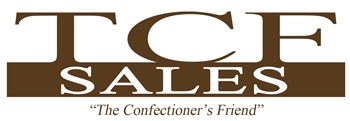Chocolate Machinery Tempering Temperatures
There are many different chocolate recipes but all fit into one of two categories: couverture chocolate or compound chocolate. TCF Sales offers couverature chocolate made by Guittard Chocolate Co. for producing fine chocolate confections and bars. This type of chocolate is cocoa-butter based and after melting requires tempering.
Manually tempering chocolate takes a bit of know how and a lot of patience and practice to perfect the technique but tempering is the only guarantee of producing fine chocolate confections with a smooth, crisp and shiny finish. All chocolate is different due to its cocoa mass and cocoa butter content, but here is a general rule-of-thumb guide for chocolate tempering temperatures for use with mainstream chocolates:
- Dark Chocolate: 88 - 90 F (31-32 C)
- Milk Chocolate: 86 - 88 F (30- 31 C)
- White Chocolate: 80 - 82 F (27-28 C)
Most chocolate manufacturers post their tempering curve temperatures on their packaging but if not, experiment using this guideline to find your chocolate's working temperature. The key element to remember when manually tempering chocolate is to thoroughly melt out the crystals from your chocolate by heating at at higher temperature such as 42°C / 107.6°F (not to exceed 45°C / 113°F) then reducing its temperature by using the seeding method or by working your chocolate on a marble, granite or stainless steel cooled slab that will slowly increase its temperature and result in a thicker mass that over time will become tempered chocolate.
If you are not familiar with chocolate tempering, you will find many u-tube videos and also a number of chocolate and confectionery schools that teach tempering and confection and truffle production techniques. Keep in mind that there are many different kinds of chocolate available for sale and what you purchase may not be considered mainstream chocolate. If you are making your own chocolate or free form style of chocolate or buying one of these, you may be working with a different viscosity or fat content that may require more effort to find best temper.
Many artisan Chocolatiers use chocolate melters for a constant supply of available melted chocolate and can temper on a slab or can temper inside their Mol d'Art chocolate melter as desired.
The chocolate temper in any machine is dependent on a number of different things:
- The type and grade of chocolate that is used
- The climatic conditions in the work area
- The temperature of the chocolate when in use
- The method of tempering
- The quality of the temper
So while the temperature of your chocolate is important to achieve proper temper, there are a variety of other factors to consider as well. Some artisan Chocolatiers teach themselves over a period of time, often 12 months or more, and many benefit from a mentoring program or some type of formal training to learn about the involved science.
Learn more more about chocolate and its terminology, storage, melting, tempering, etc., and read more about chocolate fundamentals to obtain good results.
